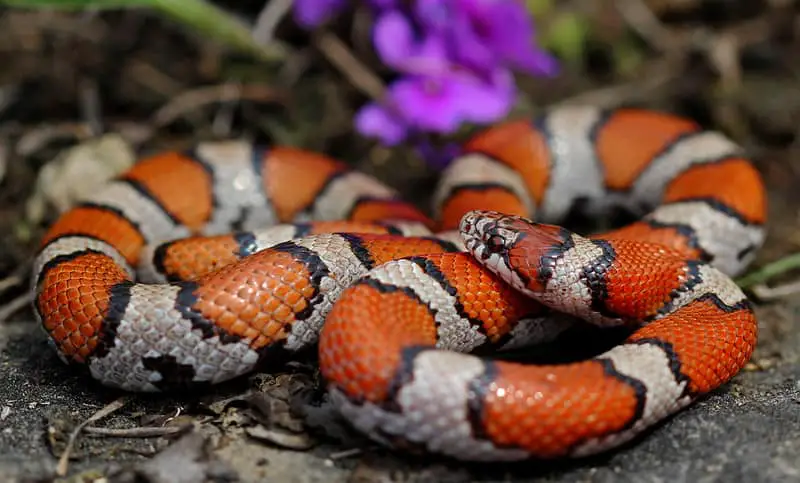Of 22 species found in New Jersey, only the timber rattlesnake and the northern copperhead are venomous. Both the copperhead and rattlesnake are reclusive and shy, but each will defend itself if threatened. In reality, though, you have a greater chance of being struck by lightning than of ever being bitten by one of these snakes.
Because snakes had a bad reputation and are so easily by the public, it's a good idea to familiarize yourself with the ones that can be dangerous and the ones that are not and are an important part of the ecosystem. This site at usasnakes.com/snakes-in-new-jersey/ has photos of both types.
The timber rattlesnake inhabits three distinct areas – the Kittatinny Ridge and the northernmost portion of the Highlands as well as the sprawling Pine Barrens of southern New Jersey. The copperhead is limited to hilly, forested regions in portions of northern New Jersey and a few isolated, hilly areas of Hunterdon and Somerset counties.
| NJ REPTILES | |||
| Endangered | Threatened | ||
| Rattlesnake, timber | Crotalus h. horridus | Snake, northern pine | Pituophis m. melanoleucus |
| Snake, corn | Elaphe g. guttata | ||
| Snake, queen | Regina septemvittata | ||
 |
| Northern copperhead Photo: Mike Muller via state.nj.us/dep/ |
Copperheads are social snakes and often hibernate in communal dens with other copperheads or other species of snakes including timber rattlesnakes and black rat snakes.
Adult copperheads eat mostly mice but will also eat small birds, lizards, small snakes, amphibians and insects, especially cicadas.
Copperheads have fangs that inject prey with a hemolytic venom that subdues its prey by causing the breakdown of red blood cells, making it easy for the snake to swallow. The copperhead seeks out its prey using its heat-sensitive pits to detect objects that are warmer than its environment. This also enables them to find nocturnal mammalian prey.
A copperhead, one of New Jersey’s least common snakes, is frequently confused with the northern water snake and the eastern milk snake, among the state's most common species. Copperheads have a dark-colored pattern that forms hourglass-shaped bands from side to side, but coloration is highly variable among individuals and changes according to seasonal shedding periods.
You should never approach this snake, or try to handle it, or disturb it. Copperheads and other snakes help to control rodent populations in its environment."
Adult copperheads eat mostly mice but will also eat small birds, lizards, small snakes, amphibians and insects, especially cicadas.
Copperheads have fangs that inject prey with a hemolytic venom that subdues its prey by causing the breakdown of red blood cells, making it easy for the snake to swallow. The copperhead seeks out its prey using its heat-sensitive pits to detect objects that are warmer than its environment. This also enables them to find nocturnal mammalian prey.
A copperhead, one of New Jersey’s least common snakes, is frequently confused with the northern water snake and the eastern milk snake, among the state's most common species. Copperheads have a dark-colored pattern that forms hourglass-shaped bands from side to side, but coloration is highly variable among individuals and changes according to seasonal shedding periods.
You should never approach this snake, or try to handle it, or disturb it. Copperheads and other snakes help to control rodent populations in its environment."
 |
| Timber rattlesnake Photo by Kris Schantz via state.nj.us/dep/ |
The timber rattlesnake inhabits three distinct areas – the Kittatinny Ridge and the northernmost portion of the Highlands as well as the sprawling Pine Barrens of southern New Jersey. The copperhead is limited to hilly, forested regions in portions of northern New Jersey and a few isolated, hilly areas of Hunterdon and Somerset counties.
While the rattlesnake has its rattle to distinguish it from other snakes, many other snakes mimic the rattlesnake by shaking their tails on leaves, twigs and other objects. A rattlesnake has jagged and dark bands extending from side to side around the center and back end of the snake.
The snake below may look dangerous but it is a non-venomous milk snake Lampropeltis Triangulum. Because it has color variations, it can be confused with some venomous snakes.
Know your Jersey snakes!
For more information, see state.nj.us/dep/daw/snakes/

5 comments:
Someone posted elsewhere on this blog a comment about spotting a cottonmouth snake in southern NJ. I am re-posting my reply here as it's a more applicable post location.
Cottonmouths are venomous semi-aquatic snakes often referred to as “water moccasins.” Their range is south of NJ with the northern terminus listed as northern Virginia. Often, the non-venomous northern water snake is misidentified as the water moccasin (cottonmouth) which does
not occur in New Jersey. The only possibility would be if one was placed here by someone and in that case it would likely not survive the range of seasons.
Look at the online brochure at http://www.state.nj.us/dep/fgw/ensp/pdf/snake_broch07.pdf
I have grown up in south jersey and am and always have been hunting and fishing since I was really small and I am really familiar with the wild life in my area and I have seen water moccasins twice in cumberland county nj
I thought I did as well but they aren't
I’ve seen Cottonmouth snakes in southern New Jersey since the 80s. Weird that I only see these 2 snakes listed everywhere.
I know, I have seen them. Up close enough to see the Cottonmouth display.
Post a Comment